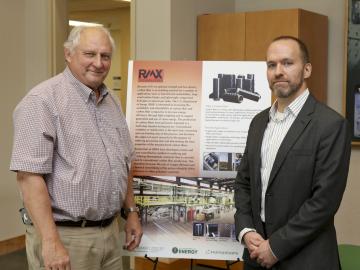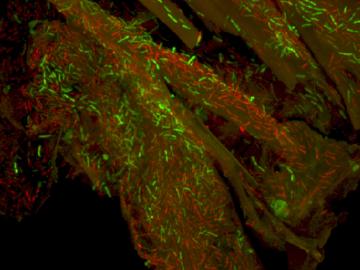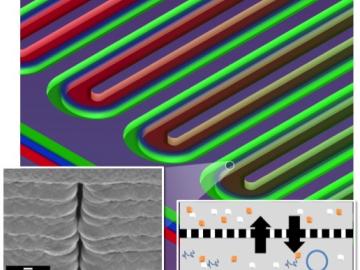
Filter News
Area of Research
- (-) Clean Energy (167)
- Advanced Manufacturing (13)
- Biological Systems (14)
- Biology and Environment (40)
- Biology and Soft Matter (1)
- Building Technologies (3)
- Chemistry and Physics at Interfaces (4)
- Climate and Environmental Systems (2)
- Computational Biology (4)
- Computational Engineering (2)
- Computer Science (4)
- Energy Frontier Research Centers (7)
- Energy Sciences (2)
- Fossil Energy (2)
- Fuel Cycle Science and Technology (1)
- Functional Materials for Energy (6)
- Fusion and Fission (17)
- Fusion Energy (2)
- Geographic Information Science and Technology (2)
- Isotope Development and Production (1)
- Isotopes (8)
- Materials (204)
- Materials Characterization (2)
- Materials for Computing (13)
- Materials Synthesis from Atoms to Systems (5)
- Materials Under Extremes (5)
- National Security (24)
- Neutron Science (77)
- Nuclear Science and Technology (24)
- Nuclear Systems Modeling, Simulation and Validation (1)
- Nuclear Systems Technology (1)
- Quantum Condensed Matter (1)
- Quantum information Science (1)
- Reactor Technology (1)
- Sensors and Controls (1)
- Supercomputing (107)
- Transportation Systems (5)
News Type
News Topics
- 3-D Printing/Advanced Manufacturing (28)
- Advanced Reactors (3)
- Artificial Intelligence (4)
- Big Data (1)
- Bioenergy (14)
- Biology (5)
- Biomedical (3)
- Biotechnology (2)
- Buildings (8)
- Chemical Sciences (10)
- Clean Water (1)
- Climate Change (6)
- Composites (5)
- Computer Science (9)
- Coronavirus (4)
- Critical Materials (4)
- Cybersecurity (3)
- Decarbonization (10)
- Energy Storage (26)
- Environment (13)
- Exascale Computing (2)
- Fossil Energy (1)
- Frontier (1)
- Fusion (1)
- Grid (9)
- High-Performance Computing (2)
- Isotopes (1)
- Machine Learning (4)
- Materials (17)
- Materials Science (11)
- Mercury (1)
- Microscopy (4)
- Molten Salt (1)
- Nanotechnology (5)
- National Security (4)
- Net Zero (1)
- Neutron Science (7)
- Nuclear Energy (4)
- Partnerships (8)
- Physics (1)
- Polymers (5)
- Quantum Science (1)
- Renewable Energy (1)
- Security (3)
- Simulation (1)
- Summit (2)
- Sustainable Energy (24)
- Transformational Challenge Reactor (3)
- Transportation (17)
Media Contacts

RMX Technologies of Knoxville, Tenn., and the Department of Energy’s Oak Ridge National Laboratory have signed an exclusive licensing agreement for a new technology that dramatically reduces the time and energy needed in the production of carbon fiber. Lowering the ...

Four Oak Ridge National Laboratory researchers specializing in environmental, biological and computational science are among 49 recipients of Department of Energy's Office of Science Early Career Research Program awards. The Early Career Research Program, now in its ...

Four Department of Energy national laboratories are joining Oak Ridge National Laboratory to expand an online crowdsourcing community for building technologies called JUMP, which bridges the gap between cutting-edge ideas and the marketplace. Joining ORNL in JUMP...

Researchers and others interested in establishing a sustainable bioeconomy in the U.S. are taking part in a five-day study tour led by the Department of Energy’s Oak Ridge National Laboratory. Approximately 70 attendees from DOE and its national laboratories, the ...

A 20-kilowatt wireless charging system demonstrated at the Department of Energy’s Oak Ridge National Laboratory has achieved 90 percent efficiency at three times the rate of the plug-in systems commonly used for electric vehicles today. This ability can help acc...

Researchers at the Department of Energy’s Oak Ridge National Laboratory have demonstrated a production method they estimate will reduce the cost of carbon fiber as much as 50 percent and the energy used in its production by more than 60 percent. After extensive ...

Experts at the U.S. Department of Energy’s Oak Ridge National Laboratory will help nine small companies move their innovative manufacturing, buildings, fuel cell, geothermal and vehicle technologies closer to the marketplace. The businesses are among 33 selected t...

Three U.S. Department of Energy-funded research centers – the BioEnergy Science Center (Oak Ridge National Laboratory), the Great Lakes Bioenergy Research Center (University of Wisconsin–Madison and Michigan State University), and the Joint BioEnergy Institute (Lawrence Berkeley National Laboratory) – are making progress on a shared mission to develop technologies that will bring advanced biofuels to the marketplace, reporting today the disclosure of their 500th invention.




